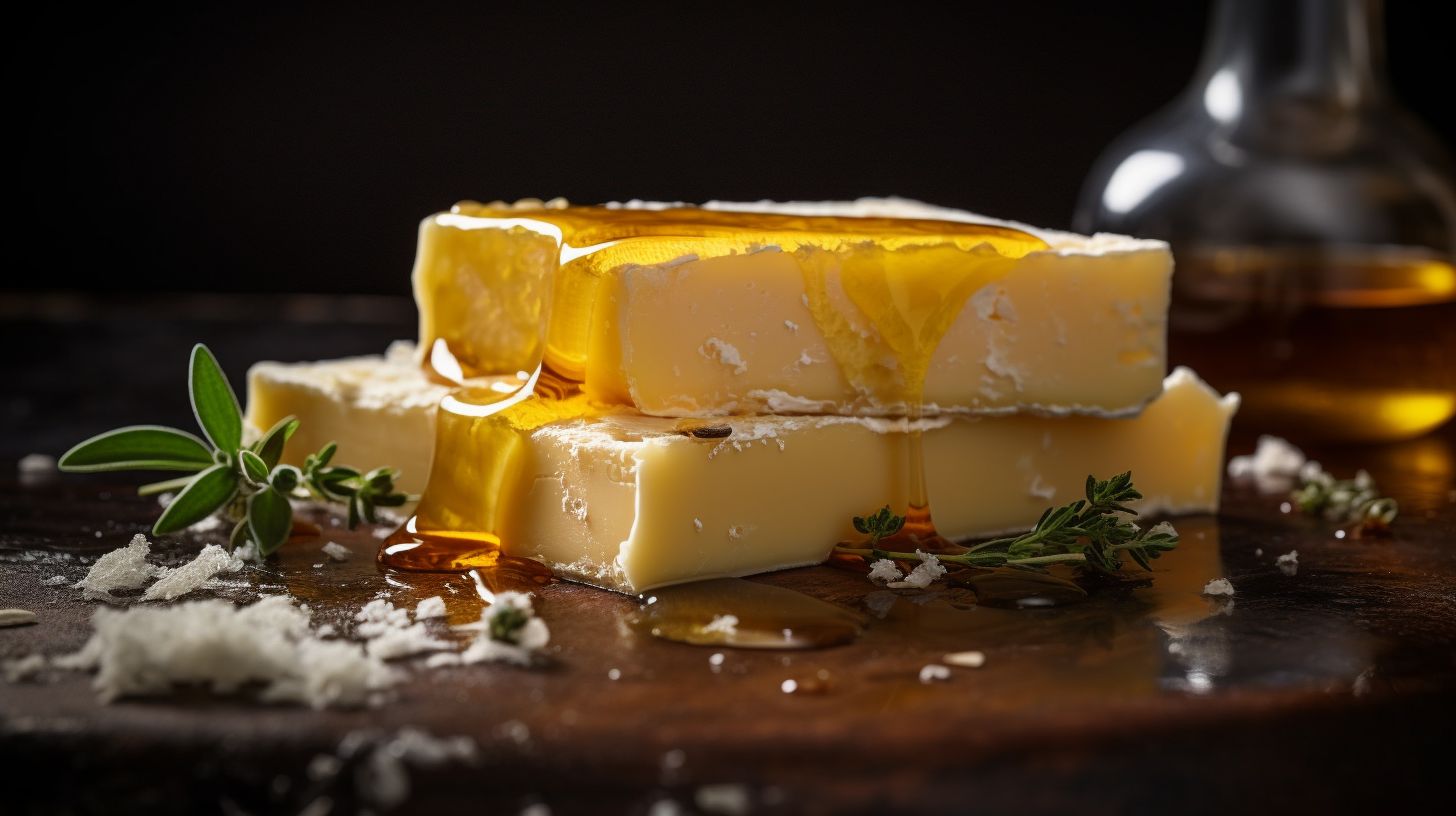Are you torn between using ghee or tallow for your cooking needs? These two types of fats, popular among chefs and home cooks alike, offer unique flavors and health benefits. This blog will peel back the layers of these substances, comparing their origins, nutritional value, flavor profiles, and uses in cooking.
Let’s dive in to explore which one is a better fit for your kitchen adventures!
Key Takeaways
- Tallow and ghee are two popular fats used in cooking that offer unique flavors and health benefits.
- Tallow, derived from beef fat, has a neutral flavor and is high in monounsaturated fats and vitamins A, D, E, and K.
- Ghee, produced by clarifying butter, has a rich nutty flavor and provides important vitamins A, C, D, and K.
- Both tallow and ghee have high smoke points, making them suitable for grilling and smoking meats and vegetables.
Understanding Ghee and Tallow
Tallow originates from beef fat and has a rich, savory flavor profile. It offers various health benefits, including high levels of monounsaturated fats and vitamins A, D, E, and K.
On the other hand, ghee is produced by clarifying butter to remove milk solids and impurities. It has a nutty and buttery flavor with similar health benefits to tallow.
Origin of Tallow
Tallow comes from the fat of cows or sheep. People make it by melting the fat and then cooling it down. This is called rendering. It is an old way to save and use all parts of these animals.
Flavor Profile of Tallow
Tallow offers a neutral flavor. This lack of strong taste makes it good for cooking many foods. It won’t change the taste of your dish. Tallow also handles high heat well. You can use it to fry or grill without worry.
Its mild taste and heat handling make tallow an easy pick for any kitchen task.
Health Benefits of Tallow
Tallow is a rich source of nutrients. It gives you vitamins A, C, D, and K. These vitamins are good for your health. They keep your body strong.
Also, tallow is full of healthy fats. It has both saturated and monounsaturated fats. These fats can raise the level of good HDL cholesterol in your body.
Another benefit of tallow is its high smoke point. This makes it perfect for high-heat cooking like grilling or smoking meat on a barbecue! While cooking with this heat, tallow keeps all its healthy parts inside it.
Production Process of Ghee
Making ghee starts with butter. The butter is heated until it melts. This makes the water in the butter turn into steam and go away. Then, solids from milk sink to the bottom of the pot.
The clear liquid left on top is ghee. It gets a rich, nutty taste when cooked this way.
Flavor Profile of Ghee
Ghee has a rich and nutty flavor that adds depth to your dishes. It has a slightly sweet and caramelized taste, making it perfect for enhancing the flavors of both savory and sweet recipes.
The clarified butter used to make ghee removes the milk solids, giving it a smoother and more refined taste compared to regular butter. Using ghee in your cooking can add a unique and delicious flavor profile to your dishes that you won’t get from other cooking fats.
Health Benefits of Ghee
Ghee has many health benefits that make it a great addition to your diet. It is rich in vitamins A, C, D, and K, which are important for overall health. Ghee is also lactose-free and does not contain unhealthy hydrogenated oils or trans fats.
Studies suggest that ghee may have anti-inflammatory properties and can support digestion and improve gut health. So incorporating ghee into your cooking can be a delicious way to boost your nutrient intake and promote better well-being.
Distinguishing Between Tallow and Ghee

When it comes to distinguishing between tallow and ghee, there are notable differences in both flavor and health benefits.
Differences in Flavor
Tallow and ghee have different flavors. Tallow has a neutral flavor, which means it doesn’t have a strong taste. On the other hand, ghee has a rich and nutty flavor that adds depth to your dishes.
So if you want a more subtle taste, go for tallow, but if you want something richer, ghee is the way to go.
Differences in Health Benefits
Tallow and ghee have different health benefits. Tallow is a good source of saturated and monounsaturated fats, which can be beneficial for your health. These fats are important for various body functions and can help maintain healthy cholesterol levels.
On the other hand, ghee provides vitamins A, C, D, and K. These vitamins are essential for supporting your immune system, promoting bone health, and protecting against certain diseases.
So, while tallow is rich in beneficial fats, ghee offers important vitamins that can contribute to overall well-being.
Utilizing Tallow and Ghee in Cooking
Using Tallow for Grilling and Smoking adds a rich, savory flavor to meats, while Ghee is perfect for high heat cooking with its higher smoke point.
Using Tallow for Grilling and Smoking
Tallow is great for grilling and smoking because it can seal in flavor and add a delicious taste to your food. Here are some ways you can use tallow for grilling and smoking:
- Searing steaks: Rub tallow on your steak before grilling to create a flavorful crust and lock in the juices.
- Smoking brisket: Coat your brisket with tallow before putting it in the smoker. The tallow will help keep the meat moist and enhance the smoky flavor.
- Grilled vegetables: Toss vegetables like potatoes, zucchini, or bell peppers in melted tallow before grilling. It will give them a rich, savory flavor and prevent them from sticking to the grill.
- Foil-wrapped dishes: When cooking foil-wrapped dishes on the grill, add a dollop of tallow to each packet before sealing them up. The tallow will melt and infuse the ingredients with its delicious taste.
- High-heat cooking: Tallow has a high smoke point, making it ideal for high-heat cooking methods like grilling and searing. It won’t break down or become rancid at high temperatures.
Using Ghee for Grilling and Smoking
Ghee is a great option for grilling and smoking because it has a high smoke point. Here are some ways you can use ghee for these cooking methods:
- Brush ghee on your meats before grilling to help enhance the flavor and create a delicious crust.
- Use ghee as a marinade for your meats before smoking them to add moisture and richness to the final dish.
- Melt ghee and mix it with spices to create a flavorful baste for your grilled or smoked vegetables.
- Coat your grill grates with ghee to prevent sticking and add an extra layer of flavor to your food.
Sustainability and Versatility of Tallow and Ghee in Cooking

Tallow and ghee are sustainable options for cooking because they come from animal sources. Tallow is derived from cow or sheep fat, while ghee is made from regular butter. Both tallow and ghee can be used as oil or fat substitutes in various cooking methods, making them versatile ingredients in the kitchen.
They have high smoke points, which means they can withstand high heat without losing their nutritional value. This makes them perfect for grilling and smoking meats and vegetables.
Plus, tallow has a neutral flavor while ghee has a rich, nutty flavor, adding deliciousness to dishes. So whether you want to cook a steak on the grill or sauté some veggies on the stove, tallow and ghee are excellent choices that offer sustainability and versatility in your cooking adventures.
Economic Benefits of Using Tallow and Ghee
Using tallow and ghee in cooking can provide economic benefits. Tallow is often less expensive compared to other oils or fats, making it a cost-effective option for cooking and grilling.
It can also be reused multiple times, further stretching your budget. Ghee, on the other hand, may be more expensive than regular butter but has a longer shelf life due to the removal of milk solids.
This means you can store it for a longer time without worrying about spoilage. Additionally, both tallow and ghee have high smoke points, which means they can withstand high temperatures without burning or breaking down easily.
This allows you to use them for frying and sautéing at higher heat settings, reducing the need for excessive oil or fat usage in your recipes. Overall, incorporating tallow and ghee into your cooking routine can help save money while still enjoying delicious and nutritious meals.
Conclusion
In conclusion, understanding the differences between ghee and tallow can help you make informed choices when it comes to cooking. Tallow, derived from animals like cows or sheep, has a neutral flavor and is rich in saturated and monounsaturated fats.
On the other hand, ghee, made from butter, has a nutty flavor and provides important vitamins. Both tallow and ghee have high smoke points, making them suitable for various cooking methods like grilling and smoking.
Consider using these versatile ingredients in your kitchen for healthier and flavorful dishes.
FAQs
1. What are Ghee and Tallow?
Ghee is a type of clarified butter, a dairy product that has had its milk solids removed. Tallow, on the other hand, is animal fat, often beef or sheep fat.
2. How do ghee and tallow differ in cooking uses?
Both Ghee and Tallow can be used for grilling, smoking, searing steak and as oil substitutes for high heat cooking due to their high smoke points. However, ghee might add more flavor to your meals than tallow.
3. Are there nutritional differences between ghee vs tallow?
Yes! While both offer healthy fats like saturated fats and monosaturated fats; Ghee also provides vitamins A,C,D,K compared to beef tallow which doesn’t.
4. Can I use either ghee or tallow for skin care?
Yes! Both Ghee and Tallow can be applied on the skin thanks to their richness in fatty acids & vitamin content but people often prefer using tallow over ghee for skincare purposes due to its higher absorption rate.
5. Do all types of animal fat qualify as “talloW”?
No! Lard comes from pig fat while crisp-delicacy known as Tallows usually comes from rendering down beef or mutton (sheep) Fat only.
6.How does dietary preference impact my choice between using gheE vs TalloW?
If you’re following diets like Paleo or avoiding dairy products then you’d most likely opt for Grass-fed Beef-TallOw Over Organic GrasS-Fed GhEE.


